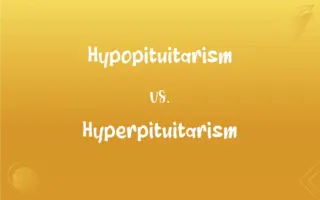Semiconservative Replication vs. Dispersive Replication: What's the Difference?
By Janet White & Harlon Moss || Published on March 19, 2024
Semiconservative replication ensures each new DNA molecule contains one original strand and one newly synthesized strand. Dispersive replication, suggests new DNA molecules are a patchwork of original and new DNA segments throughout each strand.
Key Differences
Semiconservative replication, as established by the Meselson-Stahl experiment, is the universally accepted model of DNA replication. It posits that each of the two strands of the DNA molecule serves as a template for the synthesis of a new complementary strand. Following replication, each DNA molecule consists of one original (parental) strand and one newly synthesized strand. This process ensures genetic consistency across generations, with each new cell receiving an exact copy of the DNA.
Dispersive replication was an alternative hypothesis that suggested each strand of the newly replicated DNA molecules would be a mix of old and new DNA segments. According to this model, the parental DNA strands would be cut into sections during replication, and new DNA would be interspersed among the old segments, resulting in daughter strands that are a patchwork of old and new DNA. This model was largely ruled out by the same Meselson-Stahl experiment that confirmed semiconservative replication, as the dispersive model would result in a more uniform distribution of old and new DNA within a single strand, which was not observed.
The key difference between these two models lies in the handling of the original DNA strands during replication. Semiconservative replication maintains the integrity of each parental strand, incorporating it whole into the new DNA molecules. Dispersive replication, on the other hand, would involve the fragmentation of parental strands and their distribution throughout the newly synthesized DNA, a process not supported by empirical evidence.
Semiconservative replication's fidelity is crucial for genetic stability, ensuring that errors during DNA replication can be corrected and that each cell inherits an accurate copy of the genome. Dispersive replication, if it were the mechanism of DNA replication, would potentially introduce a higher rate of genetic errors due to the random mixing of old and new DNA segments, affecting the organism's genetic integrity.
In practical terms, the understanding of semiconservative replication has profound implications for fields such as genetics, molecular biology, and medicine, underpinning the mechanisms of genetic inheritance, mutation, and DNA repair. Dispersive replication remains a theoretical model that, while interesting from a historical and educational perspective, does not describe the actual process of DNA replication in cells.
ADVERTISEMENT
Comparison Chart
Definition
Each new DNA molecule consists of one original strand and one new strand.
New DNA molecules are a mix of original and new DNA segments throughout each strand.
Empirical Support
Confirmed by Meselson-Stahl experiment.
Largely disproven by the same experiment.
Genetic Stability
Maintains genetic consistency and allows for error correction.
Would potentially introduce higher rates of genetic errors.
Mechanism
Parental DNA strands serve as templates for new strands.
Parental strands are theorized to be fragmented and interspersed with new DNA.
Practical Implications
Fundamental to understanding genetics, mutation, and DNA repair mechanisms.
Serves as a historical model for educational purposes.
ADVERTISEMENT
Semiconservative Replication and Dispersive Replication Definitions
Semiconservative Replication
Basis for DNA error correction.
Semiconservative replication allows enzymes to correct errors by using the unchanged parental strand as a template.
Dispersive Replication
Suggests mixed old and new DNA segments.
In dispersive replication, DNA strands would consist of interspersed old and new segments.
Semiconservative Replication
Crucial for genetic inheritance.
Semiconservative replication is key to the accurate inheritance of genetic material across generations.
Dispersive Replication
Largely disproven by empirical evidence.
The dispersive replication model was not supported by the results of the Meselson-Stahl experiment.
Semiconservative Replication
Supported by Meselson-Stahl experiment.
The Meselson-Stahl experiment used isotopic labeling to confirm semiconservative replication.
Dispersive Replication
Historical interest.
Dispersive replication remains a topic of interest for understanding the development of molecular biology theories.
Semiconservative Replication
Ensures genetic consistency.
Semiconservative replication ensures each daughter cell receives an exact copy of the DNA.
Dispersive Replication
Would increase genetic errors.
Dispersive replication could lead to a higher incidence of mutations due to the random integration of DNA segments.
Semiconservative Replication
Involves one parental and one new strand.
The DNA molecule after semiconservative replication consists of one old and one new strand.
Dispersive Replication
Theoretical model of DNA replication.
Dispersive replication was proposed as a potential method of DNA synthesis.
FAQs
What is the significance of the Meselson-Stahl experiment?
The Meselson-Stahl experiment provided empirical evidence supporting the semiconservative model of DNA replication, disproving the dispersive and conservative replication models.
Can the dispersive replication model be applied to any biological processes?
While the dispersive replication model does not describe DNA replication, understanding its theoretical basis can provide insights into the complexity of genetic processes and the historical development of scientific theories.
Why is semiconservative replication important for genetic stability?
It ensures that each new DNA molecule contains one intact parental strand, allowing for accurate replication and error correction, thereby maintaining genetic stability.
How does the cell ensure the accuracy of semiconservative replication?
The cell employs various proofreading and repair mechanisms, including the exonuclease activity of DNA polymerase, which corrects mismatched nucleotides, and additional repair enzymes that fix any errors post-replication, ensuring the high accuracy of semiconservative replication.
What would be the implications of dispersive replication for DNA repair mechanisms?
If dispersive replication occurred, DNA repair mechanisms might face challenges in identifying and correcting errors due to the fragmented nature of parental DNA within the strands, potentially complicating the maintenance of genomic integrity.
How does the initiation of semiconservative replication differ in prokaryotes and eukaryotes?
In prokaryotes, semiconservative replication begins at a single origin of replication and proceeds bidirectionally, whereas eukaryotes have multiple origins of replication to efficiently copy their larger genomes, demonstrating the complexity and adaptability of the replication process across different life forms.
How does semiconservative replication contribute to evolutionary processes?
By ensuring accurate DNA replication with minimal errors, semiconservative replication allows for the slow accumulation of genetic variations over time, contributing to evolution while maintaining species integrity.
Are there any organisms or viruses that do not follow the semiconservative model of replication?
All known cellular organisms follow the semiconservative model. However, certain viruses employ unique replication mechanisms, such as reverse transcription in retroviruses, which involve copying RNA into DNA, diverging from the traditional semiconservative DNA replication model.
How would dispersive replication theoretically affect genetic mutation rates?
If DNA was replicated dispersively, the random mixing of old and new DNA could potentially increase mutation rates by complicating the error correction process.
How do cells regulate the timing and initiation of semiconservative replication?
Cells regulate replication through a complex network of signaling pathways and protein interactions, ensuring that replication initiates only once per cell cycle and is tightly coordinated with cell growth and division to maintain genomic integrity.
How do different environmental conditions affect semiconservative replication?
Environmental conditions such as temperature, pH, and chemical exposure can affect the efficiency and fidelity of semiconservative replication by impacting enzyme activity, DNA stability, and the likelihood of mutations, highlighting the robustness of cellular mechanisms to ensure accurate DNA replication under varying conditions.
How might the concept of semiconservative replication inform cancer research and treatment?
Understanding DNA replication errors that lead to mutations can inform cancer research, as disruptions in semiconservative replication are often linked to cancer development. Targeting specific replication proteins or pathways offers potential avenues for cancer treatment and prevention.
What implications does semiconservative replication have for aging and genetic diseases?
Errors in semiconservative replication can accumulate over time, contributing to aging and the development of genetic diseases. Research into replication fidelity and repair mechanisms could lead to interventions that mitigate these effects, improving healthspan and understanding the genetic basis of age-related diseases.
What role does DNA polymerase play in semiconservative replication?
DNA polymerase is essential for semiconservative replication, as it synthesizes new DNA strands by adding nucleotides complementary to the template strand, ensuring fidelity and efficiency in DNA replication.
How has the understanding of semiconservative replication impacted genetic engineering?
Knowledge of semiconservative replication has been crucial for genetic engineering, enabling techniques like PCR (polymerase chain reaction) for amplifying DNA, gene cloning, and CRISPR-Cas9 gene editing by manipulating the replication process for specific outcomes.
What advancements in technology have been made to study DNA replication models?
Advances in molecular biology techniques, such as next-generation sequencing, single-molecule real-time (SMRT) sequencing, and atomic force microscopy, have enhanced our understanding of DNA replication processes, confirming semiconservative replication and providing insights into the dynamics of replication complexes.
What was the alternative to semiconservative and dispersive replication models proposed before their confirmation?
The conservative replication model was another alternative, suggesting that the parental DNA molecule remains intact while a completely new copy is synthesized. This model was also disproven by the Meselson-Stahl experiment, which confirmed the semiconservative nature of DNA replication.
How do replication forks function in semiconservative replication?
Replication forks are the sites where DNA unwinds and replication occurs, featuring leading and lagging strands. DNA polymerase synthesizes the leading strand continuously and the lagging strand in Okazaki fragments, ensuring efficient and accurate replication of both DNA strands in a semiconservative manner.
What future research directions could further our understanding of DNA replication?
Future research may explore the detailed mechanisms of replication initiation, the resolution of replication stress and conflicts, and the interaction between replication machinery and chromatin structure, offering deeper insights into the regulation and fidelity of DNA replication.
What challenges do researchers face when studying DNA replication mechanisms?
Studying DNA replication presents challenges such as replicating the complex and dynamic nature of replication processes in vitro, visualizing real-time replication events at the molecular level, and understanding the coordination of replication with other cellular processes.
About Author
Written by
Janet WhiteJanet White has been an esteemed writer and blogger for Difference Wiki. Holding a Master's degree in Science and Medical Journalism from the prestigious Boston University, she has consistently demonstrated her expertise and passion for her field. When she's not immersed in her work, Janet relishes her time exercising, delving into a good book, and cherishing moments with friends and family.
Co-written by
Harlon MossHarlon is a seasoned quality moderator and accomplished content writer for Difference Wiki. An alumnus of the prestigious University of California, he earned his degree in Computer Science. Leveraging his academic background, Harlon brings a meticulous and informed perspective to his work, ensuring content accuracy and excellence.
































































